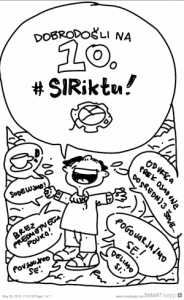Mojca Filipčič, Ginnasio Antonio Sema
The paper presents an alternative approach to interpretation of Shakespeare sonnets (specifically Sonnet 130)through stop-motion technique. This year marks the 400 anniversary of the death of this exceptional playwright and poet, moreover, the sonnet is on the list of texts students have to interpret when taking their A-levels in English. Students master new technology quickly, they use it extensively in their free time, however, less when learning. The project aims to encourage students to explore the possibilities that technology offers, seek information on the web, use it to create their own interpretation, and express their creativity. As the students work on the project in groups, the purpose is for them to get used to the concept of team work and use paper figurines in stop-motion technique to recreate the famous sonnet. This visual interpretation of the sonnet is set as a combination of frontal and group work in the classroom, followed by individual and group work in students’ spare time, where the responsibility for learning in entirely left to the students. The introductory lesson is a braistorming activity on the author and historical period. Each student has to answer a set of questions about the author and period (webquest) using online resources. The findings are presented in class. Students in groups choose to interpret the sonnet by the help of information on the web. This is followed by the presentation of the “stop-motion” technique. The central part of the project consists of making precise scenario, where students in each verse, indicate actions and cut-out figurines needed in each scene. Because students need to have the movements of the figurines synchronised with the speech (each verse), the text of the sonnet is previously recorded. Finally photo-shooting takes place with the final phase, i.e. the conversion of photos into movie format in the “stop-motion” technique with subtitles. Such an approach to the interpretation of literary texts, has, despite certain restrictions when using free programs, proved successful. It demands independence, compliance with time limits and technology limitations from the part of students. On the other hand it enables the expression of students’own ideas and creativity in relation to the interpretation of the work. Although the control over the individual phases of the project is indeed smaller when compared to a traditional classroom, the project can be fully implemented not only into a blended learning classroom but into an online classroom as well as.
